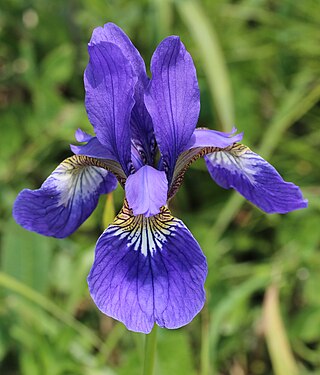
Iris sanguinea is a rhizomatous flowering plant in the genus Iris and in the series Sibiricae. It is cultivated as an ornamental plant in temperate regions. It is one of the species considered a Japanese iris. It is from Asia, found between Russia, Mongolia, China, Japan and Korea. It has grey green leaves, an unbranched flowering stem and flowers in reddish-purple shades, from blue to blue-purple, red-violet, with a rare white variant.
Iris tenuis is a plant species in the genus Iris, subgenus Limniris. It is a rhizomatous perennial, endemic to Clackamas County, Oregon. The flowers are white, pale blue or lilac, with a yellow or golden low dissected crest and pale green leaves. It is cultivated as an ornamental plant in temperate regions.

Iris orientalis is a species in the genus Iris; it is also in the subgenus Limniris and in the series Spuriae. It is a rhizomatous perennial plant, from Turkey and Greece, with white flowers with a yellow mark or blotch. It was also known as Iris ochroleuca for a long time. It is commonly known as yellow banded iris in the U.S. and Turkish iris in the UK but also has some other less common names. It is very hardy and has been known to naturalize in various countries. It is widely cultivated as an ornamental plant in temperate regions.
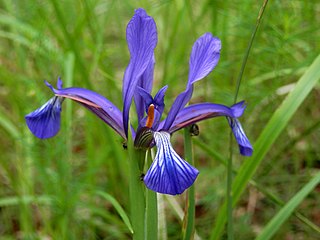
Iris sintenisii is a species in the genus Iris, in the subgenus Limniris and in series Spuriae, with tall thin stems, violet-blue flowers and long grass-like leaves. It is a rhizomatous perennial plant, from grass meadows parts of Europe, Russia, and Turkey. It is cultivated as an ornamental plant in temperate regions.
Iris xanthospuria is a species in the genus Iris, it is also in the subgenus Limniris and in the series Spuriae. It is a rhizomatous perennial plant, from Turkey with yellow flowers. It was originally known as 'Turkey yellow'. It is cultivated as an ornamental plant in temperate regions.
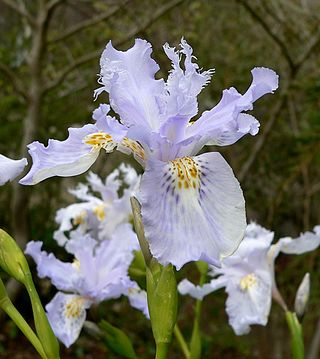
Iris wattii is a plant species in the genus Iris, it is also in the subgenus Limniris and the section Lophiris. It is a rhizomatous perennial plant. It is native to China, Burma and India, it has lavender or light blue flowers. It is also known as 'Bamboo Iris'. It is cultivated as an ornamental plant in temperate regions.
Iris bloudowii is a species in the genus Iris. It is also in the subgenus of Iris and in the Psammiris section. It is a rhizomatous perennial, from Russia, Siberia, Kazakhstan, Mongolia and China, with sickle-shaped leaves, slender stem and 2 bright or pale yellow flowers. It is cultivated as an ornamental plant in temperate regions.

Iris humilis is a plant species in the genus Iris. It is also in the subgenus of Iris and in the Psammiris section. It is a rhizomatous perennial, with a wide distribution range from Europe to Russia to China, via Mongolia and Kazakhstan. It has sword-shaped leaves, a short stem and yellow flowers with an orange beard. It is cultivated as an ornamental plant in temperate regions.
Iris mandshurica is a species in the genus Iris; it is also in the subgenus of Iris and in the Psammiris section. It is a rhizomatous perennial, it is found in Russia, China, and Korea. It has green sword-like leaves, smooth green stem and yellow flowers, with yellow-purple veining and a yellow beard. It is cultivated as an ornamental plant in temperate regions.

Iris darwasica is a plant species in the genus Iris, it is also in the subgenus Iris and in the section Regelia. It is a rhizomatous perennial, from Tajikistan and northern Afghanistan. It has long and thin glaucous to grey-green leaves, slender stem and greenish cream or greenish yellow, to dark purple or lilac flowers.
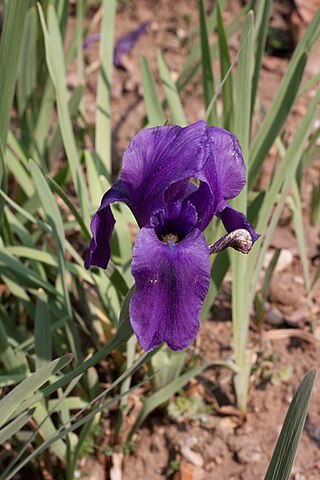
Iris hoogiana is a plant species in the genus Iris, it is also in the subgenus Iris and in the section Regelia. It is a rhizomatous perennial, from the grassy mountainsides of Turkestan. It has long green leaves, which are slightly purple at the base, and a long slender flowering stem. The flowers are blue, ranging from sky-blue to lavender blue and blue purple. It has orange or yellow beards. It is cultivated as an ornamental plant in temperate regions.

Iris korolkowii is a plant species in the genus Iris. It is also in the subgenus Iris and in the section Regelia. It is a rhizomatous perennial, from the mountains of Tien Shan, Pamir and Altai, in Afghanistan and Turkestan. It is commonly known as the Redvein Iris. It has long, sword-shaped grey-green leaves, slender stem, and 2 to 3 white, cream, pale green or light purple flowers which are veined with maroon, chocolate brown or dark purple. It is cultivated as an ornamental plant in temperate regions.
Iris dolichosiphon is a plant species in the genus Iris, it is also in the subgenus Iris and in the section Pseudoregelia. It is a rhizomatous perennial, from China and Bhutan. It has long, thin dark green leaves, very short stem, and dark blue, purple, or violet flowers. That are mottled with white. It has thick white/orange beards. It has one subspecies, Iris dolichosiphon subsp. orientalis, from China, India and Burma. It has similar flowers. They are cultivated as ornamental plants in temperate regions
Iris goniocarpa is a plant species in the genus Iris, it is also in the subgenus of Iris and in the section Pseudoregelia. It is a rhizomatous perennial, from China, India, Burma and Bhutan. It has yellow green to dark green, long leaves, slender stem and, one flower between blue, lavender-blue, lilac, blue-violet or blue-purple. It is cultivated as an ornamental plant in temperate regions.
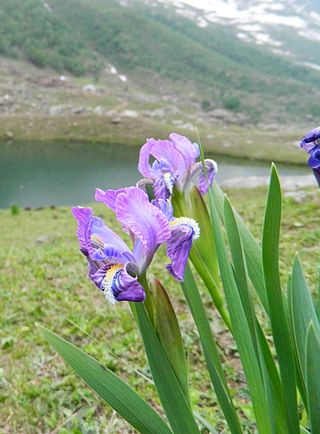
Iris hookeriana is a plant species in the genus Iris, it is also in the subgenus Iris and in the section Pseudoregelia. It is a rhizomatous perennial, from the Himalayan mountains of India and Pakistan. It has long pale green or yellow green leaves, long slender stem and fragrant blue, purple or lilac flowers, that are mottled with a darker colour. It is cultivated as an ornamental plant in temperate regions.
Iris sikkimensis is a plant species in the genus Iris, it is also in the subgenus Iris and in the section Pseudoregelia. It is a rhizomatous perennial, from Sikkim. It has pale green or light green thin leaves, slender stem, 2 or 3 lilac or purple flowers, with a white beard with orange tips. It is thought to be a hybrid of Iris hookeriana and Iris kumaonensis.
Iris alexeenkoi is a plant species in the genus Iris, it is also in the subgenus Iris. It is a rhizomatous perennial, from the Caucasus Mountains in Azerbaijan. It has green or greyish grass-like leaves, a short slender stem and 1–2 flowers that come in shades of purple, violet, purple-blue, or blue. It is closely related to Iris pumila. It is rarely cultivated as an ornamental plant in temperate regions.
Iris cypriana is a plant species in the genus Iris, it is also in the subgenus Iris. It is a rhizomatous perennial, from Cyprus. It has narrow, glaucous and evergreen leaves, tall slender stem, with 2–3 branches, and 1–3 large flowers in lavender, lilac, red-lilac, to dark purple shades. It is cultivated as an ornamental plant in temperate regions. It is listed in some sources as a synonym of Iris germanica.
Iris purpureobractea is a plant species in the genus Iris, it is also in the subgenus Iris. It is a rhizomatous perennial, from the cliffs and forest glades on the mountains of Turkey. It has straight or falcate shaped leaves, stem with several branches, the stem has purple spathes, it has up to 8 fragrant flowers, in various colours between yellow or blue. It is cultivated as an ornamental plant in temperate regions.
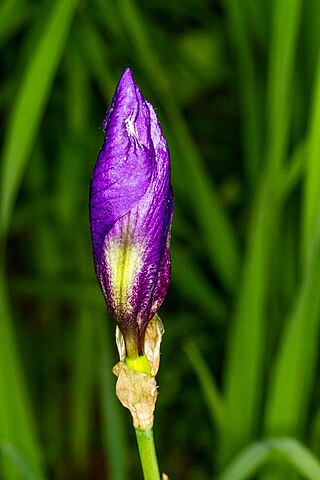
Iris sambucina, the elder scented iris, is a plant species in the genus Iris, it is also in the subgenus Iris. It is a rhizomatous perennial, from southern and central Europe. It has green, curved or sword-like leaves, tall round stem, multiple flowers in shades from brown violet, or brown-purple, to purple-violet, blue violet, mauve, and to purple. The large flowers are fragrant, with the scent of elderflowers, hence the name. It was first considered a separate species, then it was classified as a synonym of Iris germanica, before being classified as a separate species again, but with a hybrid origin from Iris pallida and Iris variegata. It is sometimes cultivated as an ornamental plant in temperate regions.










